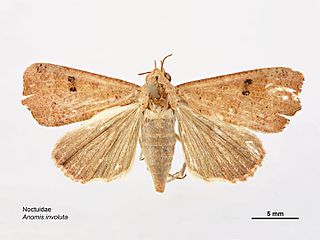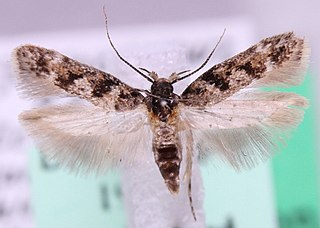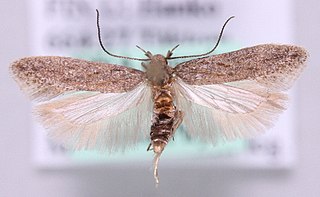
The Gelechiidae are a family of moths commonly referred to as twirler moths or gelechiid moths. They are the namesake family of the huge and little-studied superfamily Gelechioidea, and the family's taxonomy has been subject to considerable dispute. These are generally very small moths with narrow, fringed wings. The larvae of most species feed internally on various parts of their host plants, sometimes causing galls. Douglas-fir (Pseudotsuga) is a host plant common to many species of the family, particularly of the genus Chionodes, which as a result is more diverse in North America than usual for Gelechioidea.

Phthorimaea operculella, also known as the potato tuber moth or tobacco splitworm, is a moth of the family Gelechiidae. It is an oligophagous insect that feeds on the plant family Solanaceae and is especially known for being a major pest of potato crops. Currently farmers utilize insecticides, parasites, and sprinkler irrigation in order to prevent P. operculella from infesting their croplands.

Pectinophora is a genus of moths in the family Gelechiidae. Perhaps the best known species is the pink bollworm, Pectinophora gossypiella (Saunders). P. gossypiella is one of the world's most destructive insect pests that causes terrible damage to cotton bolls. The larvae (caterpillars) bore into the bolls, causing them to fall or the blossoms to fail to open. The larvae tunnel through the immature lint and into the seeds eating them. As a result the lint may be unpickable or so stunted as to greatly lower the yield and grade. The yield of oil from the seeds is greatly reduced. Double seeds are found when the cotton is gained, two partly eaten seeds being fastened together.

Scrobipalpa aptatella is a moth of the family Gelechiidae. It is found in China (Xinjiang), Australia, New Zealand, Samoa, India, Indonesia (Sumatra), Malaysia, Myanmar, Sri Lanka, Palestine and in Africa, where it has been recorded from the Democratic Republic of Congo, Kenya, Malawi, Namibia, South Africa, Tanzania and Zimbabwe.

The geranium plume moth is a moth of the family Pterophoridae. It is found in western Africa, Madagascar, India, Sri Lanka, Thailand, Japan, the New Hebrides and Central and South America, as well as Australia, where it has been recorded from Cape York to central New South Wales. It is also present in the United States, where it has been recorded from Florida, as well as Mississippi.
Pectinophora scutigera, the Queensland pink bollworm or pinkspotted bollworm, is a moth of the family Gelechiidae. It was described by Holdaway in 1926 from Australia, where it occurs in coastal and central Queensland. It has also been recorded from Hawaii, New Guinea and Micronesia.

Trigonospila brevifacies is a species of true fly in the family Tachinidae native to eastern Australia. Like the vast majority of tachinid flies, T. brevifacies is a parasitoid of other insects, specifically late larval stages of a number of species of Lepidoptera. It is also known as the Australian Leaf-Roller Fly or Leafroller Fly.

Anomis involuta, the jute looper or hibiscus cutworm, is a moth of the family Erebidae. It has a wide distribution, including the Cook Islands, Hong Kong, Japan, Korea, the Society Islands and Australia. It is also known from Kenya and Somalia.

Caryocolum alsinella is a moth of the family Gelechiidae. It is found throughout Europe It is also present in North Africa.
Caryocolum peregrinella is a moth of the family Gelechiidae. It is found in northern Spain, the southern Alps, Bosnia and Herzegovina, North Macedonia and Greece.

Caryocolum blandulella is a moth of the family Gelechiidae. It is found in Great Britain, the Netherlands, Spain, France, Germany, Denmark, Finland, Sweden, Switzerland, Italy, Croatia, Hungary, Greece and Ukraine, as well as Corsica. The habitat consists of coastal sand-dunes.

Caryocolum junctella is a moth of the family Gelechiidae. It is found from most of Europe east to China and Japan.

Carpatolechia alburnella, the suffused groundling, is a moth of the family Gelechiidae. It is found from most of Europe to Siberia. The habitat consists of woodland and heathland.
Mesophleps crocina is a moth of the family Gelechiidae. It is found in Australia.

Helcystogramma hibisci is a moth in the family Gelechiidae. It was described by Stainton in 1859. It is known from China, Taiwan, India, Thailand, Vietnam, Sri Lanka, Indonesia and Australia, where it has been recorded from the Northern Territory and Queensland.

Scrobipalpa nitentella, the common sea groundling, is a moth of the family Gelechiidae. It is found in most of Europe, North Africa (Tunisia), Turkey, Afghanistan, Kazakhstan, China, Mongolia and Siberia (Transbaikalia).
Ephysteris promptella, the ratoon shootborer, is a moth of the family Gelechiidae. It is a pantropical species, found in the warmer parts of the Old World tropics to Australia. It is widely distributed in southern Europe.
Chionodes aruns is a moth in the family Gelechiidae. It is found in North America, where it has been recorded from Alabama, Kentucky, Louisiana, Maryland, Mississippi, Ohio, Texas and Mexico.
Apatetrinae is a subfamily of moths in the family Gelechiidae. The subfamily was described by Edward Meyrick in 1947.
Decatopseustis cataphanes is a moth of the family Gelechiidae. It was described by Ian Francis Bell Common in 1958. It is found in Australia, where it has been recorded from the Australian Capital Territory.












